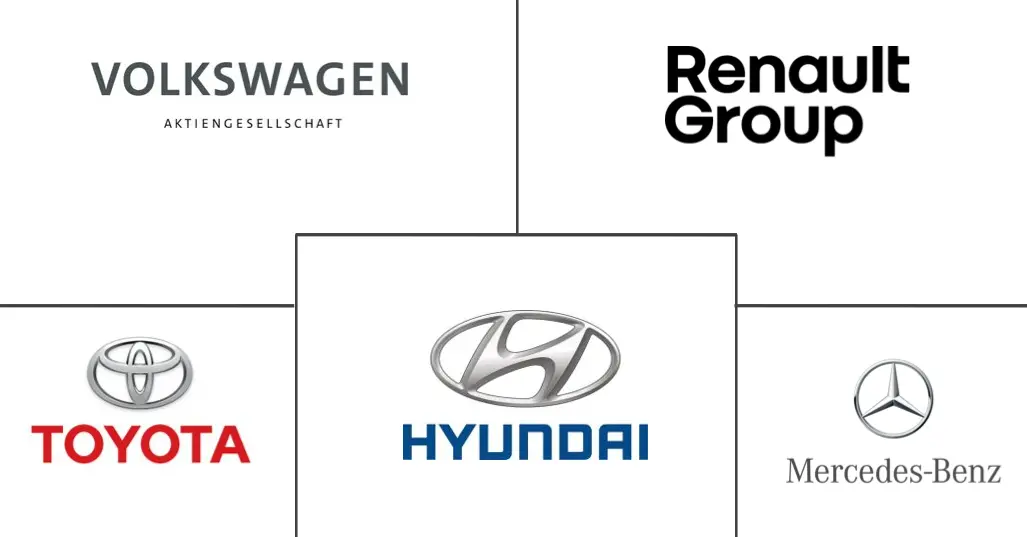Market Size of Africa Automotive Industry

| Study Period | 2019 - 2029 |
| Base Year For Estimation | 2023 |
| Market Size (2024) | USD 20.5 Billion |
| Market Size (2029) | USD 26.30 Billion |
| CAGR (2024 - 2029) | 5.10 % |
| Market Concentration | High |
Major Players
*Disclaimer: Major Players sorted in no particular order |
Africa Automotive Market Overview
The Africa Automotive Market size is estimated at USD 20.5 billion in 2024, and is expected to reach USD 26.30 billion by 2029, growing at a CAGR of 5.10% during the forecast period (2024-2029).
Over the medium term, the African automotive market is expected to grow rapidly due to supportive government incentives and increasing urbanization in the major countries in the region, which are encouraging infrastructural developments, thus creating a positive outlook for the market. Several larger countries, such as South Africa, Nigeria, and Kenya, also focus on developing domestic automotive production plans. For instance,
South Africa's policy for electrification of transport under South Africa's Just Energy Transition (JET) plan will likely produce its first electric vehicle (EV) in 2026. The JET plan estimates that the transport sector would need an investment of ZAR 128.1 billion (USD 6.84 billion) from 2023 to 2027 to contribute to South Africa's decarbonization commitments.
The South African electric mobility market offers new opportunities for foreign companies and investors to enter and expand operations.
For example, in June 2023, Germany's BM opened a new tab and will build its X3 model in South Africa from 2024, investing ZAR 4.2 billion (USD 25.09 million) to electrify its plant in Rosslyn.
Moreover, Africa's vital raw materials for modern vehicles require new technologies to reach net zero. They include copper, cobalt, bauxite, and lithium. Considering the overall economic and industrial factors, the market is expected to grow in the coming years.
Africa Automotive Industry Segmentation
The automotive industry comprises a wide range of companies and organizations involved in the design, development, manufacturing, marketing, and selling of motor vehicles. The African automotive market report covers the African market landscape and predicts the growth of its automobile market. The study also includes growth, market trends, progress, challenges, opportunities, government regulations, technology use, and growth forecasts.
By vehicle type, the market is segmented into two-wheelers, passenger cars, commercial vehicles, and three-wheelers. By fuel type, the market is segmented into diesel, petrol/gasoline, electric, CNG/LPG, and others. By country, the market is segmented into South Africa, Morocco, Algeria, Egypt, Nigeria, Ghana, Kenya, and the Rest of Africa. The report offers market size and forecasts for the African automotive market in value (USD) for all the above segments.
| Vehicle Type | |
| Passenger Cars | |
| Commercial Vehicles |
| Country | |
| South Africa | |
| Morocco | |
| Algeria | |
| Egypt | |
| Nigeria | |
| Ghana | |
| Kenya | |
| Rest of Africa |
Africa Automotive Market Size Summary
The African automotive market is poised for significant growth over the forecast period, driven by supportive government policies and increasing urbanization. Countries like South Africa, Nigeria, and Kenya are focusing on developing domestic automotive production, with initiatives such as South Africa's Just Energy Transition plan, which aims to introduce electric vehicles by 2026. This plan, along with the availability of vital raw materials like copper and lithium, is expected to attract foreign investment and technology, further boosting the market. The demand for passenger cars is rising due to improved lifestyles, increased disposable income, and a growing interest in electric vehicles, as evidenced by the introduction of models like the BYD ATTO 3 in South Africa. The market's expansion is also supported by the presence of international automobile manufacturers and the strategic initiatives of major OEMs to enhance their market share.
South Africa plays a crucial role in the African automotive sector, with its advanced infrastructure and manufacturing capabilities making it an attractive location for companies aiming to penetrate the continental market. The South African Automotive Masterplan seeks to increase vehicle production and localization, enhancing the country's global standing. Major OEMs are investing in South Africa, launching new models, and establishing strong business links with international stakeholders. The market is characterized by consolidation, with key players like Volkswagen, Toyota, and Hyundai adopting strategies such as mergers and acquisitions to maintain their positions. Recent collaborations, such as those between BMW and Sasol for hydrogen-powered vehicles, highlight the ongoing innovation and investment in the region. These developments, coupled with the growing demand for automotive aftermarket products, are expected to drive the market's momentum in the coming years.
Africa Automotive Market Size - Table of Contents
-
1. MARKET DYNAMICS
-
1.1 Market Drivers
-
1.1.1 Increasing in The Passenger Car Sales Across the Region
-
-
1.2 Market Restraints
-
1.2.1 Transportation Infrastructure Development
-
-
1.3 Industry Attractiveness - Porter's Five Forces Analysis
-
1.3.1 Bargaining Power of Suppliers
-
1.3.2 Bargaining Power of Buyers/Consumers
-
1.3.3 Threat of New Entrants
-
1.3.4 Threat of Substitute Products
-
1.3.5 Intensity of Competitive Rivalry
-
-
-
2. MARKET SEGMENTATION (Market Size by Value)
-
2.1 Vehicle Type
-
2.1.1 Passenger Cars
-
2.1.2 Commercial Vehicles
-
-
2.2 Country
-
2.2.1 South Africa
-
2.2.2 Morocco
-
2.2.3 Algeria
-
2.2.4 Egypt
-
2.2.5 Nigeria
-
2.2.6 Ghana
-
2.2.7 Kenya
-
2.2.8 Rest of Africa
-
-
Africa Automotive Market Size FAQs
How big is the Africa Automotive Market?
The Africa Automotive Market size is expected to reach USD 20.5 billion in 2024 and grow at a CAGR of 5.10% to reach USD 26.30 billion by 2029.
What is the current Africa Automotive Market size?
In 2024, the Africa Automotive Market size is expected to reach USD 20.5 billion.

